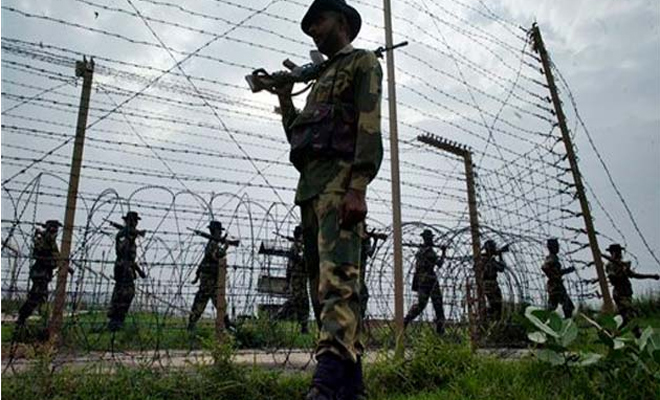The new Indian strategy is to push Pakistan against the wall before the Americans leave and showcase it as a centre of terrorism.

The Line of Control is the military control line between the Indian and Pakistani controlled parts of Jammu and Kashmir. It is more and more in the news after the Nawaz-Manmohan meeting in New York on 24th September. It was not expected to be an extremely productive meeting in the first place since Manmohan Singh is an outgoing Prime Minister.
Nevertheless, it was said to be constructive, and it was agreed to have a ceasefire on the LoC. It was decided that the Director Generals Military Operations of Pakistan and India would work together to restore normalcy at the LoC – this being the initial immediate target.
But, as a matter of fact, ever since this meeting, the temperature on the LoC is only increasing, with India upping the ante with talks of infiltrations and incursions by the Pakistan Army. Anybody that goes even slightly off track near the LoC is arrested or killed by the Indian Army contingents posted there and is proclaimed to be a terrorist.
The border area overlooking the Neelam Valley has a population of 18000 people, and still, nobody has seen any infiltrators or trespassers. Only the Indian Army sees such things. The Pakistan Army hardly fires a shot unless absolutely necessary; most of the activity there is Indian oriented. When asked for proof, the Indian side has not been able to provide any.
The elections are due this year in India, and therefore, political hawks stir up negative propaganda against Pakistan to gain more votes. It is almost an Indian tradition to make hysteric accusations on Pakistan just prior to the elections.
It is with a sense of foreboding that one watches Narendra Modi emerging as the mega-candidate for Premiership in Indian politics. His controversial history and involvement in the Gujarat massacre of Muslims hardly makes him suitable for Premiership. He was extremely averse to Pak-India peace talks just before the Nawaz-Manmohan meet. He cited the sacrifices of Indian soldiers as a reason not to have peace talks with Pakistan. Spurred on by all this hawkish rhetoric of Modi, PM Manmohan Singh made the mistake of calling Pakistan an ‘epicentre of terrorism’. This move was hardly conducive for peace. It is hoped that the Indian voters refrain from voting for Modi. The Indian Muslim vote bank is surely not his due to his bloody past.
It is the Indian endgame keeping in view the imminent departure of American forces from Afghanistan in 2014, ensuing in a Taliban government unfriendly and averse to Indian plans. This eventual scenario is making them desperate and causing them to resort to false flag setups and skirmishes on the LoC, the Pakistan-India de facto border. Their aim is to present Pakistan as a ‘centre of terrorist activity’ to the world media.
It is unbelievable that any such ‘infiltrations’ could happen in an area where the Indian Army is heavily deployed. They are equipped with all sorts of surveillance equipment, and there are even talks of drones to be used there in the future. They have built a 550 km long barrier along the 740 km long Line of Control, where there is electrified double fencing connected to sensors and thermal imaging devices, lighting systems and alarms. Such a barrier breaks all regional accords and United Nations resolutions on the matter.
The truth is that India feels insecure and exposed once the Americans leave Afghanistan in 2014, it fears a stronger Pakistan with Afghanistan by its side. The Indian Intelligence fears that the militant groups fighting in Afghanistan would now concentrate on the liberation of Kashmir. In any such eventuality, there would be no Americans to help India.
The new Indian strategy is to push Pakistan against the wall before the Americans leave and showcase it as a centre of terrorism. The immediate objective is to break the ceasefire and keep the Pakistan Army engaged on the LoC.
Their latest claim was of an infiltration in Keran Sector of the Kashmir Valley on October 4, where 1300 Gurkha Rifles have been deployed to encounter milItants since two weeks. They claim to have killed 11 milItants, but there are no bodies to be found. It is astonishing that 30 people could engage such a large deployment.
Another ultimate Indian dream is to swallow Azad Kashmir, which is a part of Pakistan, by using pressure tactics and trying to make them feel vulnerable and force them to join India. They were even warned that if India-Pakistan tensions increase, there would be nuclear war and the Kashmiris would have to bear the brunt. The Indian Police advised the residents of Indian Occupied Kashmir to build bunkers to protect themselves from nuclear blasts, and an advisory was published in the Greater Kashmir newspaper this January by the State Disaster Response Force. A nuclear war scenario was vividly described and a nuclear blast shock wave was depicted.
Meanwhile, the Indian Kashmiris are victims of torture and extreme brutality; indefinite curfew, extra-judicial killings and fake encounters are the norm. The conditions have worsened since the LoC incidents, and there is a constant heavy deployment of Indian Army. The Indian Kashmir is dealt with more like a colony than a region of India.
India’s LoC strategies might not reach their desired end, especially after the withdrawal of American troops from Afghanistan.
Recently, in a remarkable development, Lt Gen Chachra said on record in an interview to the NBC that the American withdrawal would have an impact on the security situation in Indian Kashmir. He is one of the main army officers behind the concept of India’s Cold Start Doctrine. This Doctrine was countered effectively by the Kayani Doctrine, which is basically to ‘respond within minutes’ to any Indian limited attack. Cold Start was proactive preparedness for joint military attack from both India and China under a ‘nuclear overhang’.
It is almost certain that the Afghan Taliban would return to power in Afghanistan; the military forces left behind by the Americans are the exact model they have constantly defeated for a decade. In consequence, it is likely that such a government would have a tilt toward Pakistan noticeably, and this would hanker India considerably, which would feel isolated in this region.









After U S S R withdrawal from Afghanistan , taliban and Islamist came to power in Afgjanistan and L O C was very very quite and now suddenly after 2014 U S A withdraw from Afghanistan suddenly L O C will become a war zone is difficult to understand.Most likely place of trouble seems to b Baluchistan
@ Elijash … u can just wish for Balochistan. Please update your information. It was actually opposite what you are saying. Kashmir freedom fight was increased to its peak in 90′ when USSR was defeated in late 80’s. Since 1990’s around 90 thousand Kashmiris have been killed by indian army, plus rapes. No such thing happening in Balochistan. Rather than Balochistan, you should concentrate on Kashmir, Aasam, Naxals, Tamil Nado etc. etc.